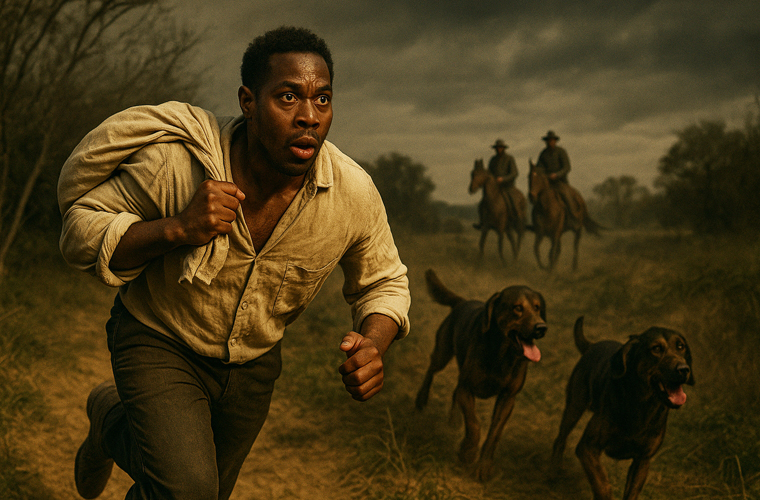A fugitive slave was someone who fled bondage during the era of American slavery, particularly in the lead-up to and during the Civil War. Typically, they sought refuge in free Northern states or Canada, though some found temporary sanctuary in Spanish-controlled Florida (linked to the Black Seminoles community).
From the outset of slavery in the United States, those in chains harbored an unquenchable longing to break free and seek security elsewhere. As abolitionist S.J. Celestine Edwards recounted in From Slavery to a Bishopric (1891), drawing from the life of escaped slave Walter Hawkins, this impulse was “an irrepressible desire for freedom which no danger or power could restrain, no hardship deter.” The perils of flight were immense and almost unimaginable. Most escapees lacked literacy, funds, or belongings, and their visible racial markers made them prime targets for pursuers—frequently aided by packs of bloodhounds—who aimed to drag them back to captivity.
Runaways often faced grueling treks on foot, spanning hundreds of miles to reach free territory or the Canadian border. Consequently, capture was the fate of the overwhelming majority. Those recaptured endured brutal punishments designed to crush any spirit of rebellion in their peers. Yet, against these odds, countless determined souls pressed northward into abolitionist havens. The sheer physical toll of such escapes meant that successful fugitives were predominantly young and male. Analysis of early 19th-century newspaper ads seeking runaways revealed that 76% were under 35 years old, with 89% being men.
The Underground Railroad marked a turning point, transforming sporadic flights into an organized lifeline. This clandestine system of sympathetic allies, hidden safe houses, and secret routes developed gradually to shepherd escapees toward liberty. “Conductors” like the legendary Harriet Tubman—herself a former slave—braved repeated Southern incursions, endangering their own lives to liberate others. Estimates suggest it facilitated the freedom of 40,000 to 100,000 people between 1800 and 1865. Even under this cover, progress was arduous: Fugitives moved in small bands under darkness, covering 10 to 20 miles (16 to 32 km) between “stations,” forever shadowed by the threat of betrayal or ambush.
For many who crossed into what was supposed to be freedom, the reality fell short of their visions. Life in Northern free states mirrored the dehumanization of the South in subtler forms—rampant segregation, prejudice, and barriers to decent work left ex-slaves scraping by in unskilled labor.
The Fugitive Slave Act of 1850 deepened this disillusionment. It imposed steep penalties on anyone obstructing a slaveholder’s pursuit and compelled officials to assist in roundups, turning Northern soil into a hunting ground. As a result, Canada emerged as the sole reliable bastion for the newly free.
Survivors of the ordeal often chronicled their harrowing paths in memoirs that exposed the raw truths of evasion. Henry Box Brown’s Narrative of the Life of Henry Box Brown (1849) details his audacious concealment in a mailed crate for the journey north. Similarly, Francis Fredric’s Slave Life in Virginia and Kentucky; or, Fifty Years of Slavery in the Southern States of America (1863) recounts his owner’s savagery and his clever ruse: Befriending the tracking dogs allowed him to slip away undetected when they were loosed in pursuit.
Few voices captured the paradox of emancipation more poignantly than Frederick Douglass, the era’s most renowned fugitive. In his writings, he described an initial rush of elation upon reaching a free state, swiftly eclipsed by dread and isolation: “I was yet liable to be taken back and subjected to all the tortures of slavery. This in itself was enough to dampen the ardor of my enthusiasm. But the loneliness overcame me. There I was in the midst of thousands, and yet a perfect stranger; without home and without friends, in the midst of thousands of my own brethren—children of a common Father, and yet I dared not to unfold to any one of them my sad condition.”
These tales of peril and resilience echo through American literary masterpieces. Harriet Beecher Stowe’s Uncle Tom’s Cabin (1852), despite its dated sensibilities, vividly illustrates the fugitive’s gamble through Eliza Harris, who flees with her infant son to evade his sale to a distant planter. In Mark Twain’s The Adventures of Huckleberry Finn (1884), the enslaved Jim embodies quiet dignity as he aids the runaway Huck Finn, their bond hinting at interracial harmony beyond chains—though Twain’s depiction has sparked debate over its nuances of empathy and stereotype. More modernly, Toni Morrison’s Beloved (1987), a Pulitzer-winning tour de force, reimagines the trauma from a woman’s gaze: Sethe, inspired by real history, slays her toddler daughter to spare her re-enslavement, underscoring the desperate calculus of flight.

